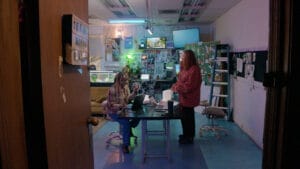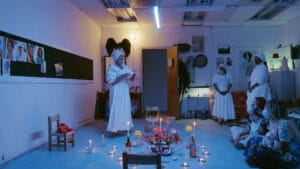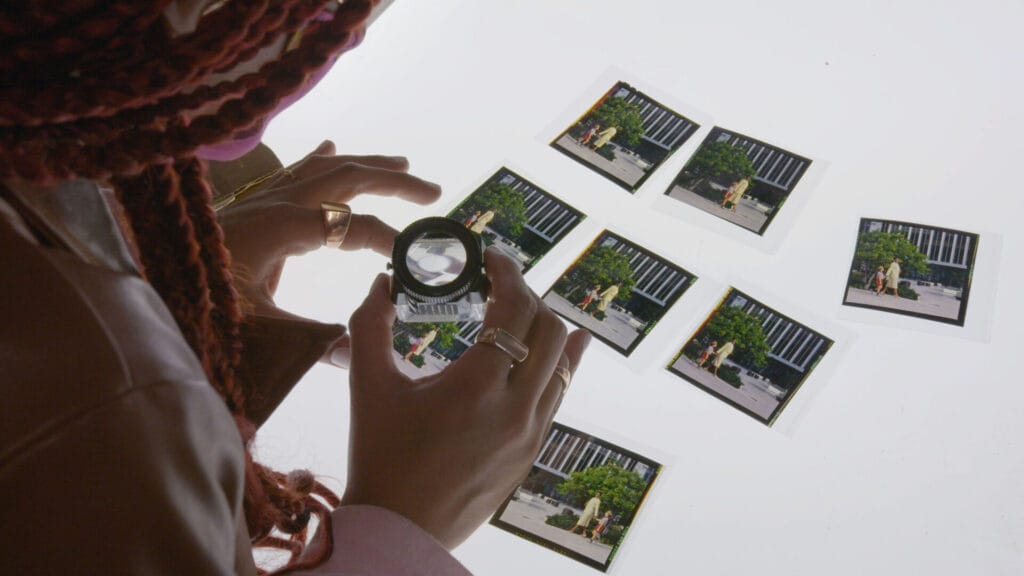An unconventional foray into investigative film, the aesthetics and ethics of the archive, and both the possibilities and the dangers present in the digital realm, Jazmin Jones’ Seeking Mavis Beacon is a ramifying film, made only more powerful through its vulnerability and depth.
Computer software “Mavis Beacon Teaches Typing” debuted in 1987. The program’s packaging, and the typing instruction itself, depicted the image of a Black woman as Mavis Beacon, but, unbeknownst to many, Mavis Beacon was completely fictional. The models that took on her image and character changed numerous times over the course of the software’s evolution and development. The genre-defying film serves, in part, as a record of the journey Jones and their collaborator/associate producer, Olivia McKayla Ross, took to find the woman behind the popularized character of Mavis Beacon.

Throughout Seeking Mavis Beacon, including in a moving scene before an interview with two of the software’s original developers, both Jones and Ross share that their earliest and most pivotal experiences of seeing themselves represented in digital spaces were through “Mavis Beacon Teaches Typing.” While the team ultimately isn’t able to make direct contact with the original model (Renée L’Espérance) who brought Mavis Beacon to life and share with her the importance of her legacy, the film brings up and documents valuable questions and nuanced reflections surrounding privacy, visibility, exploitation, representation, history and data, and archival preservation.
Using digital storytelling elements to illuminate both the past and future allowed Jones to explore and write new possibilities for Mavis Beacon into a multimedia archive and historical register. Having to find new modes and methods to research, unearth, and tell our stories is a common practice for LGBTQ+ people of color, whose stories are so often erased and buried that we have to take on the task of creating new ones.

The film is populated and inspired by Black queer community, stories, and storytellers (including creators and producers Jones and Ross) whose influences form the basis of a film that is equal parts probing, tender, relentless, and full of care. In addition to widely renowned and recognized influences and references such as Cheryl Dunye’s seminal queer film “The Watermelon Woman” (1997) and the opening epigraph of Jones’ film: “Sometimes you have to create your own history,” the film draws from, discovers, and shares the work of many Black queer films, filmmakers, and artists that never received the attention they deserved.

Seeking Mavis Beacon, along with Jones’ other films and work, is a testament to the power of LGBTQ+ storytellers of color to forge history, and the powerful lens through which we see and create, the boundless possibilities and potential of the stories our community can tell when given the range and opportunity.
Last week, at Sundance Film Festival, we caught up in-person with Jones and Ross to discuss Seeking Mavis Beacon, the power of imagination and digital arts in storytelling, and advocating for yourself and your perspective in entertainment and media. Read on for a glimpse into our conversation and the Black queer brilliance behind the film:
_____
Kayla Thompson: It’s so nice to meet both of you! My name is Kayla Thompson, I work with GLAAD’s Communities of Color and Media Department and I’m so excited to talk with you all today. Jumping right in, I loved the film. It was so powerful, and I thought one of the most compelling parts for me was the connection between the two of you and the bond you had as investigators, collaborators, etc. How did you two connect and get started, and what made you want to do this kind of archival work on the Mavis Beacon story.
Olivia McKayla Ross: I met Jaz a couple days after my high school graduation. I was a student volunteer at IO Festival and Jaz’s collective was presenting. And I remember just playing musical chairs with the other volunteers so that I could be the one who was pouring water for the group because I wanted to be in their panel. And I remember being very impacted by the inherent collaborative nature of the work Jaz was doing even then.
And after departing from a really competitive high school that was very much about the individual, like you gotta be a genius, you gotta go to Harvard, it was a very tech space, and I think it was very healing that summer to be involved with the community organizing that Jaz was doing. I just learned so much very quickly about what it actually meant to be a young queer person, a young queer black person, in the world.
Jazmin Jones: I feel like this is a very humble telling of the story. Seeing Olivia, I was like “Who is this person with the digital blue braids, running around on top of everything?” For me, I was truly introduced to Olivia’s mind and her power in editing. So the collective, we had like our own decentralized, wifi school with BUFU. And the idea is like, education is violent, academia is violent, so we’re going to get all these people to volunteer to lead classes around love, technology, spirituality, the body, etc. And Olivia taught a class on her 18th birthday called Drafting Neo-Cyber Feminism for Us. I wasn’t at the class in person, but I edited it and was like, “Who is this brilliant person?”
OMR: And then you came and gave a presentation at the School for Poetic Computation where I was a student and I said “Do you need a producer?”
JJ: We need to check the stats but she might be my youngest producer.
KT: I love that. And I wish I had taken that class hearing about it. What you were both just saying reminds me that while I was watching the film, I was thinking a lot about the Saidiya Hartman quote “So much of the work of oppression is policing the imagination.” And I think the film just does such a great job of almost acting as a form of resistance and refusing to let its imagination be policed, and your imaginations as well. I think it’s probably really different from what most people have seen because of the digital storytelling elements that you introduce into the structure. Is there any particular reason you took this route while you were trying to tell this story and get at the truths you were searching for?
JJ: Yeah, I think the hybridity was so compelling to me because there’s only so much there’s only so much information about Mavis Beacon. She’s a typing teacher. I knew pretty much from the start that she wasn’t real. And I was like, regardless of her not being real, let’s slow down. I don’t have enough role models in the early days of tech that are black women. So, what if we just all collectively imagine the backstory for her? That would be nice, right?
I appreciate you bringing up Saidiya Hartman. A quote that I used a lot in development is from Adrienne Maree Brown: “We can imagine so much. We can only imagine so much.” And that’s how it feels. You have to see something in order to think, “Oh, I can do that.” So Mavis Beacon, regardless of if she was real, she made a lot of people feel like they were proficient and good with computers and technology.
OMR: When I was coming up on the internet, it was a very wild, wild west kind of vibe, where we were in the middle of commercializing the internet. So it wasn’t the kind of wild west that Jaz had, where freedom of expression was still kind of the dominant mode of how people were engaging. Like Instagram came out when I was getting my first digital device, which was an iPod Touch and had the touchscreen. I remember going to Pinterest and looking up “Black Girl Hairstyles” and getting non-Black girls with black hair. And just like a sense of like, oh, the computer does not know that I am a Black girl behind the screen, and it also doesn’t care. And that is like, this is an environment that I know that no one is waiting for me in, no one is expecting me here. And it was a kind of a very early sense of being an interloper.
KT: I think that’s so interesting because I didn’t have social media or technology until I was much older, but I think that data trauma that you’re talking about still catches up to you. People are still sharing traumatic videos or homophobic or transphobic or discriminatory rhetoric, over and over.
And, thinking about something you said Jazmin, about Mavis Beacon being this first instance of affirmation for so many people. There’s a point in the documentary where you interview someone who says, “I don’t want to be a perfect black person all the time.” That really called me to the way that, so often, creators of color and especially Black queer creatives, people who live at this intersection of multiple marginalized identities, are pigeon holed or expected to produce a specific type of content or a specific type of story. People tend to expect a specific narrative. Has that come up for either of you, with this project or others?
OMR: I feel like, at least for me, that scene calls attention to the way that, when you work on a project like this or you’re reading a project like this, there’s an urge to be like, “Oh, my God, finally, representation. Representation is so amazing.” And I feel like the instinct to think that representation or an image of a Black, queer person in film is the only marker of success is something to be pushed back on, particularly because the thing that is represented even more robustly and importantly are Black queer ideas and philosophies.
The actual purpose of representing these people isn’t just so that you can see their face and so that you can hear what they’re saying. It’s to integrate liberatory philosophies into your understanding of technology. And I think the film is succeeding in that way in terms of just people like coming back to us and saying, “Wow, I’ve never thought about this that way.” We want the people who our audience to see people like them, but the people who aren’t necessarily our audience, I don’t want the thing that they gain from this to be representation of Black people. I want you to actually, like change your relationship to technology. Right now. Let’s do something different.
JJ: Everything Olivia said. Run all that. But, for me also, I’m coming from a punk framework of doing things too. I’ve seen a lot of films where the characters are imperfect. And that’s what makes them interesting. I just never seen them quite like Olivia and I. Recently in production and seeing the film “drylongso” so by Cauleen Smith I thought, where was this my entire life? I thought I was paying homage to “The Watermelon Woman,” and I am, but seeing these two Black characters who are riding around in a convertible in Oakland building these kinds of things to honor their ancestors, and also pulling tarot cards… I was like, wait, I’ve been in conversation with this. This is what I pay homage to.
Similarly, we were talking about seeing “Chocolate Babies” for the first time and wondering at how this film was made so long ago, never got any press, and is accurately bottling up the conversations that Olivia and I are having in collective organizing, and not wrapping it up in a perfect bow of representation. And acknowledging that when it comes to things like colorism and gender and the idea of us all working together, it’s messy and it doesn’t always wrap up in a bow. So yeah, I think this is part of a lineage of queer cinema and punk cinema. And I’m excited about that.
KT: That was so perfect. Going off what you were just saying, I love the way that Black and Black queer culture and ideology, and scenes of life and joy were integrated throughout the film, even with Mavis Beacon being the focal point. There’s just this rich and varied cultural tapestry that came along with the discoveries and the inquiries. And while you weren’t able to get in touch with Renee, I wondered what the experience of being able to get in touch with so many others who wanted to contribute to this legacy, and this project, what was that like for you? And what did that like hold as an experience?
JJ: I think having put ourselves on camera for years, I now understand what a huge ask that is, what a huge lift that is. Specifically when I think about like the experts that are interviewed in this film, Legacy Russell, Mandy Harris Williams, Stephanie Dinkins, these are all people that we are living in community with. I just felt so honored with the amount of trust that everyone that participated in this film has given me. The amount of, actually, we trust the process has been really affirming to me, and has added to the pressure.
KT: I have so many questions left for you all, but this will be my last one. Towards the end of the film, Olivia, you talked about encountering different barriers within the arts and digital arts. Do either of you have any advice for newcomers just getting started in the industry? Especially Black queer people or people who come from marginalized backgrounds and who have less access to resources?
JJ: Finesse. I think, Olivia, what was the quote your mom said?
OMR: Let them tell you no.
JJ: Yes, let them tell you no. I honestly had this idea of how movies get made, like you have to have all these accolades. In reality, I believe that it was audacity that got us here. I truly believe it was the merit of the pitch. I think, force yourself into spaces, ask people for free stuff, ask for what you’re entitled to.
Throughout the making of this film I’ve been lucky because there are a lot of people who are trusting the vision, both at NEON and BelleMoon and in our own teams. We were also told, there’s nothing like this, it isn’t quite the form we were expecting, maybe it’s a little too chaotic, maybe you’re doing too much. And the very things that we were concerned about in the edit are the things we’re being praised for now that the film’s out. So make it weird, make it yourself. Who cares about production quality, the camera that you have is the most compelling one, it doesn’t have to be perfect. Imperfect is actually more interesting.
OMR: I think resourcefulness and just like, who said always leave someplace with something in your hand. The art of that. It’s a shame that there’s such a vibrant tradition of Black films that have made something out of nothing. That process, the skill of that, and the specific techniques of just creating are very, very revolutionary. There’s an impulse, when you get more, when you actually start to get accolades, and you start to actually get access to things that you didn’t have access to before, it’s possible for some of the creativity to leave. In a very real way, Black people are some of the closest to life because we’re the closest to death in a lot of instances. And I think that vibrancy is palpable.
KT: That’s fantastic. That was lovely. I think I could talk to you both forever and keep the conversation going. Thank you both so much. You’re lovely and brilliant, and we can’t wait to see what the future holds for “Seeking Mavis Beacon” and your other work.
_____
This rendition of Mavis Beacon’s story, and the investigation into her whereabouts, concludes with a scene of Jazmin talking with family members. One family member, addressing Jones, says “You’re in that space where dream becomes vision and vision becomes reality.”
If Jazmin and Olivia’s efforts with Seeking Mavis Beacon are any indicator of the caliber of work to come, the entertainment industry can expect many more stories championing Black and Black LGBTQ+ people come to life through Jazmin and Olivia’s dreams. We can’t wait to see which of their dreams become vision, become reality, next.
_____
SYNOPSIS:
One of the most influential women in technology is a figment of our collective imagination. Mavis Beacon was created in Silicon Valley to sell the world’s most popular typing software, but the Haitian woman who modeled for the program disappeared from the public eye. Following two DIY “e-girl investigators” searching for the unsung cultural icon, Seeking Mavis Beacon poses questions regarding digital security, artificial intelligence, and representation.













